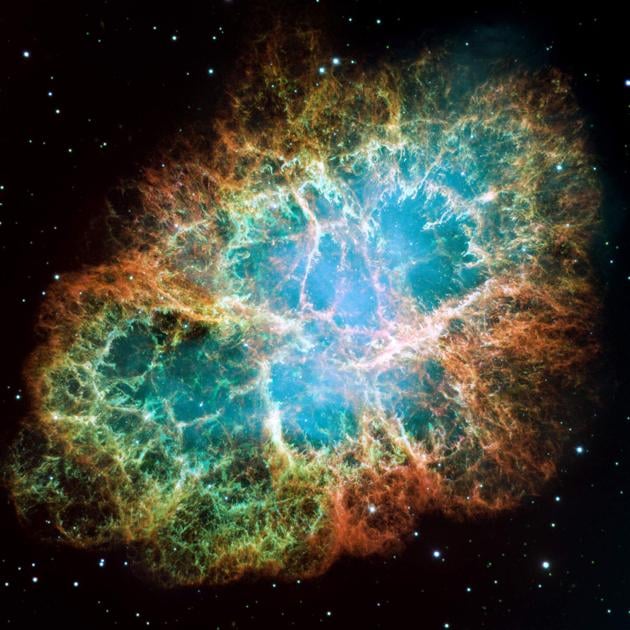
A few weeks ago, we learned about the Orion nebula, a place where new stars are being born. Today, we look at a very different type of nebula, one that represents the death of a star.
This region of the sky where the Crab Nebula now resides was first noted by Chinese astronomers in 1054 CE when a new star, or nova, appeared near the tip of one of the horns of the constellation we refer to today as Taurus.
What these astronomers saw 1,000 years ago was not a new star, but was instead the end of the life of an old star.
When stars that are many times more massive than the sun begin to fuse iron in their core, the end comes quickly. The energy required to bind the protons and neutrons together in the nucleus of an iron atom is greater than the energy produced by the nuclear fusion process that creates these atoms.
As a result, the outward push of radiation pressure generated by fusion in the cores of these massive stars is reduced to the point where it no longer balances against the inward pull of gravity, and the star collapses. Once started, it takes less than one second for the star to collapse.
The resulting increase in temperature and pressure leads to the formation of heavier and heavier elements and a tremendous amount of energy is created. The star then explodes as a supernova.
Since the star at the center of the Crab Nebula went supernova, the ejected material has expanded to a diameter of over 10 light years. That ejecta is currently traveling at nearly 1,000 miles per second.
The star did not blow itself completely to bits. Where once there was a star perhaps a few million miles across now sits a neutron star, an object we call the Crab Pulsar. The Crab Pulsar is about 1.5 times more massive than the sun and has a diameter between 12 and 20 miles. This incredibly compact and massive object is also spinning rapidly, about 30 times per second.
A clear night, relatively dark skies, and a pair of binoculars are all you need to catch a glimpse of the Crab Nebula, the remnant of an exploded star that lies 6,300 light years away.
The Morning Sky
Venus rises only about an hour before the sun and is getting harder to see low on the eastern horizon before dawn. Much higher in the eastern morning sky is the bright orange star Arcturus in the constellation Boötes.
The Evening Sky
Saturn and Jupiter are difficult to spot low in the west as night falls. The innermost planet, Mercury, appears a little higher in the western sky every night as it heads toward greatest eastern elongation on Jan. 24. The constellation Taurus the bull is well up in the east after sunset. Look for a V-shaped pattern of stars, known as the Hyades, that includes the bright orange-red star Aldebaran, the eye of the bull. Follow the “horn” that projects from Aldebaran to its tip to help you find the Crab Nebula. Use a star chart or astronomy app.
Dan Price is a NASA/JPL Solar System Ambassador and informal educator. Join him at Josephine Sculpture Park on Jan. 23 for a telescopic Night Sky Tour. Please see the JSP website for details. Have a question about astronomy or space science? Send an email to dan@starpointestudio.com and it might be featured in a future column.
Thanks for reading Bluegrass Skies: Crab Nebula represents the death of a star - State-Journal.com. Please share...!

0 Comment for "Bluegrass Skies: Crab Nebula represents the death of a star - State-Journal.com"